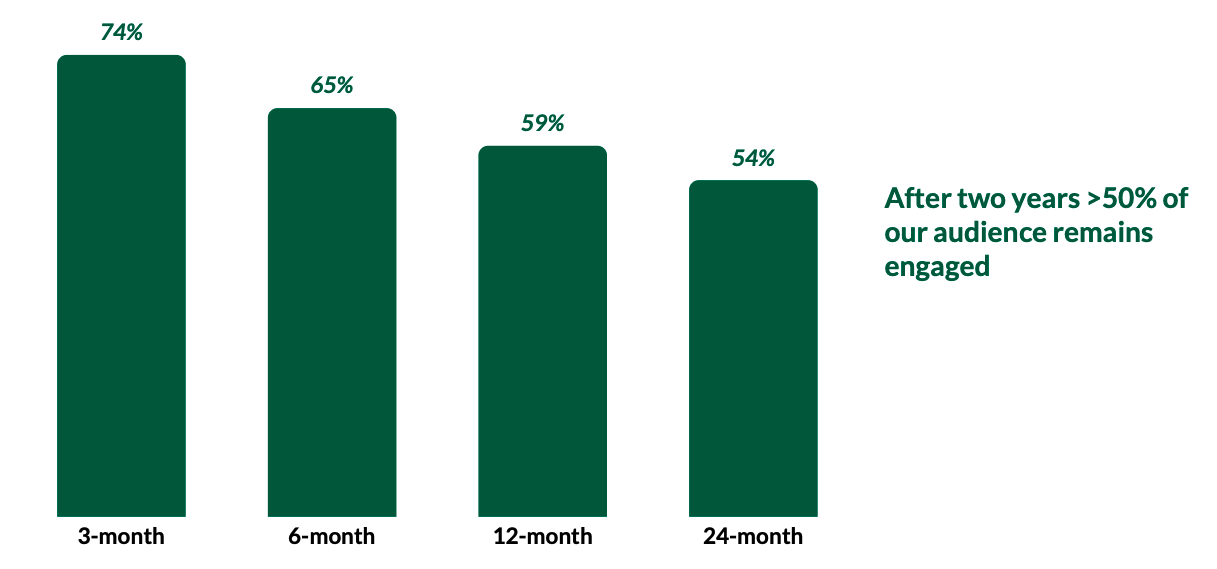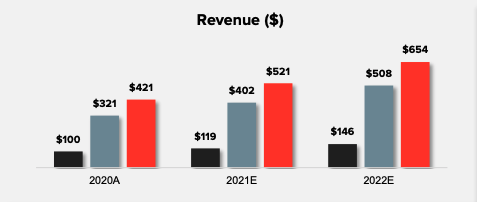The digital media industry will give us plenty to talk about this year.
When we last surveyed venture capitalists about their media investments, the big topic was the impact that the pandemic would have on the industry, and on the prospects for new startups.
Obviously, the pandemic hasn’t gone away, but when asked to predict the biggest storylines for 2021, VCs pointed to themes as varied as new distribution models, new kinds of interactivity, new tools for creators, the return of advertising business models and even the role of media in a democratic society.
“We are headed toward a content universe where consumers’ power of choice grows to new heights — what premium content to consume and pay for, and how to consume it,” Javelin’s Alex Gurevich wrote. “The consumers will have the final choice! Not traditional media and content distribution companies.”
For this new survey, we heard from 10 VCs — nine who invest in media startups, plus a tenth who’s seeing plenty of media pitches and was happy to share her thoughts. We asked them about the likelihood of further industry consolidation, whether we’ll see more digital media companies take the SPAC route and of course, what they’re looking for in their next investment.
Here’s who we surveyed:
- Daniel Gulati, founding partner, Forecast Fund
- Alex Gurevich, managing director, Javelin Venture Partners
- Matthew Hartman, partner, Betaworks Ventures
- Jerry Lu, senior associate, Maveron
- Jana Messerschmidt, partner, Lightspeed Venture Partners
- Michael Palank, general partner, MaC Venture Capital (with additional commentary from MaC’s Marlon Nichols)
- Pär-Jörgen Pärson, general partner, Northzone
- M.G. Siegler, general partner, GV
- Laurel Touby, managing director, Supernode Ventures
- Hans Tung, managing partner, GGV Capital
Read their full responses below.
What do you think will be the biggest trend or story in digital media in 2021?
Daniel Gulati: Defining media’s role in a democratic society. What accountability exists when an individual company’s pursuit of scale leads to the spread of disinformation? When a platform’s terms of service appears to collide with constitutional rights, who makes the call and what happens? To what extent should governments support the viability of local media organizations in the face of global competition and a rapidly changing digital landscape?
These are high stakes issues that will be front and center through the year.
Alex Gurevich: The continued disruption of content distribution models, whether that’s the debundling of cable via the plethora of SVOD services, or the way new content is released (i.e., on-demand at home versus movie theaters). We are headed toward a content universe where consumers’ power of choice grows to new heights — what premium content to consume and pay for, and how to consume it. The consumers will have the final choice! Not traditional media and content distribution companies. The pandemic has greatly accelerated this trend.
Matthew Hartman: The two largest social networks, Twitter and Facebook, removed the account of a sitting president and a set of related, follower accounts. This has fundamentally reset the media stack. This will accelerate action the government had already planned to take, including to reshape Section 230. The ripples will be felt throughout media, affecting how news is distributed through social media, what startups can use bigger platforms to grow, what the exit options are for small talent acquisitions and the fragmentation already occurring.
Second, the rise of synthetic media. Algorithmically enhanced or created media is a shift we identified at Betaworks in 2018 and in 2021 it will only increase in scale and scope. Yes, this affects deep fake detection (with companies like Sensity.AI leading the way) and other nefarious uses — but it will also start to fundamentally reshape the way media is created, from the cost of animation to the cost of writing stories, to editing and creating CGI.
Third, game streaming will continue to grow, with audiences that are starting to blow away those of regular TV. An enormous number of people tuned in last year to watch Alexandria Ocasio-Cortez play Among Us on Twitch with popular streamers (she hit 435,000 concurrent viewers at one point). And that wasn’t even close to the biggest event ever on Twitch, David Martinez, aka TheGrefg, hit 2.4 million concurrent viewers for the unveiling of his new Fortnite skin. Game publishers have finally started to understand the power of streamers not just to launch a new game, but to revive old ones, with games that groups of streamers can play together (like Among Us or Rust) soaring in popularity this past year.
Jerry Lu: The emergence of interactive media platforms outside of just gaming.
Because of their isolation due to COVID, people are yearning for social interaction and we’re seeing greater engagement across platforms like Twitch and Zoom, which make interactive communications possible. Previous iterations of media platforms were top-down broadcast, whereby companies produced content they thought consumers would like. Over the past five years, we’ve started to see a greater shift toward the long tail, whereby content comes straight from the consumer.
Gaming and esports were at the forefront of this shift from passive content viewing to interactive entertainment experiences. I believe that 2021 will be the year when we see platforms beginning to embrace interactivity as a form of audience participation, blurring the line between viewer and active participant. I’m excited at the prospect of seeing this form of interactive content consumption applied to other sectors, like education, childcare and commerce, to name a few.
Jana Messerschmidt: We will see a proliferation of products that enable content creators to build businesses outside of traditional media companies. These creators will leverage their existing brand, following and social media engagement to become entrepreneurs, building revenue streams across multiple different products.
There are a plethora of new tools for creators: for writers (Substack, Medium), personalized video shoutouts from creators (Cameo*, PearPop), new audio platforms (Clubhouse, LockerRoom) or all-in-one tools for creators that include merch, subscriptions, tipping and more (FourthWall). Now is the time for creators to be rewarded by their fans for their content creation.
Historically, the big social platforms (Facebook, Instagram, Snap*, Twitter, TikTok) have failed to create meaningful paths for their creators to monetize. They make money from advertisers and thus their resources are focused on those advertising customer demands.
- denotes Lightspeed portfolio company
Michael Palank: If 2020 was the year every major media company either announced or grew their direct-to-consumer video/audio/gaming offering, 2021 will be the year where those offerings optimize and differentiate or die. We expect the hunger for original content to continue, but we feel the type of content will continue to diversify from both a story and IP perspective and a format perspective. It is not unthinkable that a major media company like Apple, Amazon or Disney looks to acquire Clubhouse in 2021.
As the lines between video games and filmed entertainment continue to blur we can also envision new companies popping up to take advantage of this trend. I also feel these content platforms will need to differentiate by way of better discovery and personalization.
I fully expect every major media company from Disney to Apple to Amazon to Microsoft will be looking for new and innovative ways to separate themselves from the rest of the pack in 2021.
Marlon Nichols: I think that the continued creation of streaming platforms from content creators/owners (e.g., Disney+, HBO Max, etc.) will force downward subscription pricing adjustments across the board and streaming platforms will need to revisit advertising as a revenue stream. That said, we know that watching ads on a paid platform won’t fly with consumers so I believe we’ll see contextually relevant product placement become the accepted form of brand/content collaboration going forward. I led MaC’s investment into Ryff because of this thesis.
Pär-Jörgen Pärson: Institutions and legislators will have a big effect on social media platforms. I think there will be pushes on antitrust behavior, and social networks will have to behave like media — meaning that they also need to take responsibility for the content that’s on their platform, not only from a user agreement standpoint like today but from an editorial standpoint. I think we’ll see many more editors-in-chief in this industry, as editorial becomes more and more important in our polarized world. This has the potential to change the social media platform landscape quite dramatically, and I’m not entirely sure yet on the long-term impact commercially.
M.G. Siegler: It’s sort of boring, but I wouldn’t be shocked if we see a swing back toward advertising-based models. I think there are two parts to this: First, if and when the pandemic recedes, I think a lot of traditional big advertising players like travel, will come roaring back. Second, it feels like there’s been a move away from advertising to paid subscriptions for a while now and I think these things are cyclical.
To be clear, I think both will continue to exist, I just think that after years of underindexing on paid subs, now we’re perhaps on the verge of overindexing on it … Obviously, advertising never went away, I just think it may be due for a bit of a renaissance (though I say that hoping the powers that be make those ads a better user experience — I think that’s the only way there’s not another backlash against them).
Laurel Touby: The biggest trend in digital media will be companies that don’t call themselves media companies, but that clearly draw from the business model playbook of media companies. For example: Companies that monetize their communities by giving sponsors and advertisers access to their audiences; or technology startups that sell wearable products and upsell their customers with access to premium high-value content.
Hans Tung: Contextual social networks: Video and livestreaming with the likes of TikTok and with other players like Instagram and Snap will continue to drive creativity and engagement. Clubhouse is now garnering a lot of attention as audio captures the attention of a new generation. This also creates new opportunities for established audio players like YY or Ximalaya. At the same time, apps like Clubhouse are an evolution of Snap or Twitter where influencers of all sorts gather to build a new following on new platforms.
However, one of the most interesting things we’re seeing is the emergence of contextual social networks that are focused on solving real-life problems. We see a lot more companies taking the best of audio and video experiences and experimenting with the next iteration of apps like Headspace and Calm, to solve societal issues, personal issues such as how to deal with anxiety, etc. These social networks may not scale as quickly or grab headlines like Clubhouse but they’re designed to bring people together to solve problems. We are also seeing professionalized networks such as Valence or Chief use these audio/video networks to address issues for a particular gender or underrepresented group, or apps that create virtual networking for communities.
Digital media delivered with differentiated experiences: Peloton may not immediately jump to mind as a digital-media company but they are one of the best at producing a high-value experience using extremely high-quality content that goes far beyond simple fitness or even the need for hardware. Increasingly more categories will become “Netflix-ized” where content is king and the experience is delivered through your smartphone.
As with Peloton, the experience is further enhanced with social interaction, such as leader boards, access to the best instructors, etc., which in turn expands the reach of the content. It’s a powerful loop that is driven by quality content, and the components feed off each other to make it more accessible. If you then couple it with Affirm to make it more affordable, you’ve got a flywheel on steroids. This pattern will emerge in other categories.
Consumerization of enterprise communication: Another aspect of media is communication, which we are seeing evolve in the enterprise space. It started with Slack a few years ago and Zoom more recently. Now with companies like Yak or the emergence of various conference apps, we see a higher usage frequency between companies, companies and their customers, and within the enterprise itself.
How much time are you spending looking at media startups right now?




 You can detect the theme.
You can detect the theme.